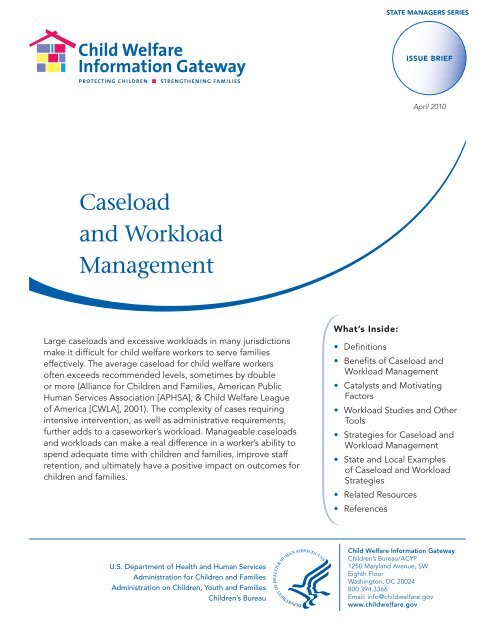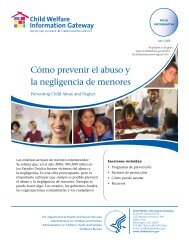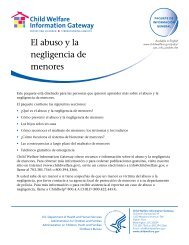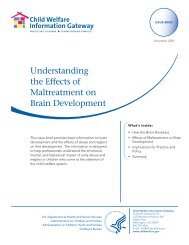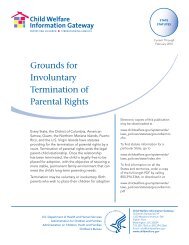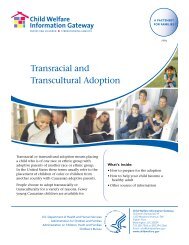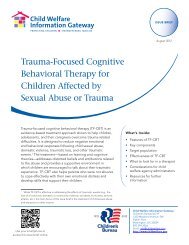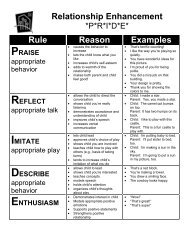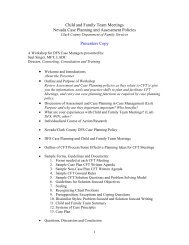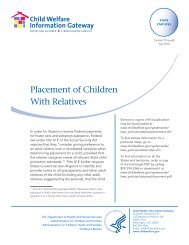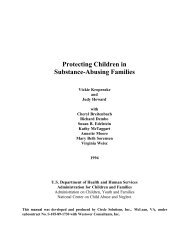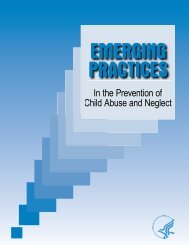Caseload and Workload Management - Child Welfare Information ...
Caseload and Workload Management - Child Welfare Information ...
Caseload and Workload Management - Child Welfare Information ...
Create successful ePaper yourself
Turn your PDF publications into a flip-book with our unique Google optimized e-Paper software.
<strong>Caseload</strong><br />
<strong>and</strong> <strong>Workload</strong><br />
<strong>Management</strong><br />
Large caseloads <strong>and</strong> excessive workloads in many jurisdictions<br />
make it difficult for child welfare workers to serve families<br />
effectively. The average caseload for child welfare workers<br />
often exceeds recommended levels, sometimes by double<br />
or more (Alliance for <strong>Child</strong>ren <strong>and</strong> Families, American Public<br />
Human Services Association [APHSA], & <strong>Child</strong> <strong>Welfare</strong> League<br />
of America [CWLA], 2001). The complexity of cases requiring<br />
intensive intervention, as well as administrative requirements,<br />
further adds to a caseworker’s workload. Manageable caseloads<br />
<strong>and</strong> workloads can make a real difference in a worker’s ability to<br />
spend adequate time with children <strong>and</strong> families, improve staff<br />
retention, <strong>and</strong> ultimately have a positive impact on outcomes for<br />
children <strong>and</strong> families.<br />
U.S. Department of Health <strong>and</strong> Human Services<br />
Administration for <strong>Child</strong>ren <strong>and</strong> Families<br />
Administration on <strong>Child</strong>ren, Youth <strong>and</strong> Families<br />
<strong>Child</strong>ren’s Bureau<br />
What’s Inside:<br />
sTATe MANAGers serIes<br />
Issue brIef<br />
April 2010<br />
• Definitions<br />
• Benefits of <strong>Caseload</strong> <strong>and</strong><br />
<strong>Workload</strong> <strong>Management</strong><br />
• Catalysts <strong>and</strong> Motivating<br />
Factors<br />
• <strong>Workload</strong> Studies <strong>and</strong> Other<br />
Tools<br />
• Strategies for <strong>Caseload</strong> <strong>and</strong><br />
<strong>Workload</strong> <strong>Management</strong><br />
• State <strong>and</strong> Local Examples<br />
of <strong>Caseload</strong> <strong>and</strong> <strong>Workload</strong><br />
Strategies<br />
• Related Resources<br />
• References<br />
<strong>Child</strong> <strong>Welfare</strong> <strong>Information</strong> Gateway<br />
<strong>Child</strong>ren’s Bureau/ACYF<br />
1250 Maryl<strong>and</strong> Avenue, SW<br />
Eighth Floor<br />
Washington, DC 20024<br />
800.394.3366<br />
Email: info@childwelfare.gov<br />
www.childwelfare.gov
<strong>Caseload</strong> <strong>and</strong> <strong>Workload</strong> <strong>Management</strong> www.childwelfare.gov<br />
Reducing <strong>and</strong> managing caseloads <strong>and</strong><br />
workloads are not simple tasks for child<br />
welfare administrators. Agencies face a<br />
number of challenges, including negotiating<br />
budget crises <strong>and</strong> hiring freezes, addressing<br />
worker turnover, finding qualified applicants<br />
for open positions, implementing timeintensive<br />
best practices, <strong>and</strong> managing<br />
multiple reforms simultaneously (Day &<br />
Peterson, 2008). Even the basic determination<br />
of what caseloads <strong>and</strong> workloads currently are<br />
<strong>and</strong> what they should be can be thorny.<br />
Nevertheless, States are addressing these<br />
challenges <strong>and</strong> successfully implementing a<br />
variety of strategies to make caseloads <strong>and</strong><br />
workloads more manageable. Approaches<br />
range from adding <strong>and</strong> retaining staff<br />
to improving worker effectiveness to<br />
implementing system improvements.<br />
In an effort to build the workload knowledge<br />
base <strong>and</strong> share lessons learned across States,<br />
this information brief provides State child<br />
welfare managers with an overview of:<br />
•<br />
•<br />
•<br />
•<br />
•<br />
•<br />
The benefits of caseload <strong>and</strong> workload<br />
management<br />
Catalysts <strong>and</strong> motivating factors<br />
<strong>Workload</strong> studies <strong>and</strong> other tools<br />
Strategies for caseload <strong>and</strong> workload<br />
management<br />
State <strong>and</strong> local examples of caseload <strong>and</strong><br />
workload strategies<br />
Related resources<br />
defInItIons<br />
• <strong>Caseload</strong>: The number of cases<br />
(children or families) assigned to an<br />
individual worker in a given time period.<br />
<strong>Caseload</strong> reflects a ratio of cases (or<br />
clients) to staff members <strong>and</strong> may be<br />
measured for an individual worker, all<br />
workers assigned to a specific type of<br />
case, or all workers in a specified area<br />
(e.g., agency or region).<br />
• <strong>Workload</strong>: The amount of work<br />
required to successfully manage<br />
assigned cases <strong>and</strong> bring them to<br />
resolution. <strong>Workload</strong> reflects the<br />
average time it takes a worker to (1) do<br />
the work required for each assigned<br />
case; <strong>and</strong> (2) complete other noncasework<br />
responsibilities.<br />
benefits of <strong>Caseload</strong> <strong>and</strong><br />
<strong>Workload</strong> <strong>Management</strong><br />
<strong>Caseload</strong> <strong>and</strong> workload management<br />
often appear as key ingredients in a State’s<br />
comprehensive strategy to produce better<br />
outcomes for children <strong>and</strong> families. The<br />
benefits of reasonable caseloads <strong>and</strong><br />
manageable workloads relate to:<br />
• Retaining staff <strong>and</strong> reducing turnover.<br />
Heavy caseloads <strong>and</strong> workloads have<br />
been cited repeatedly as key reasons that<br />
workers leave the child welfare workforce<br />
(Zlotnik, DePanfilis, Daining, & Lane, 2005;<br />
U.S. General Accounting Office [GAO],<br />
This material may be freely reproduced <strong>and</strong> distributed. However, when doing so, please credit <strong>Child</strong> <strong>Welfare</strong><br />
<strong>Information</strong> Gateway. Available online at www.childwelfare.gov/pubs/case_work_management/<br />
2
<strong>Caseload</strong> <strong>and</strong> <strong>Workload</strong> <strong>Management</strong><br />
2003; Gonzalez, Faller, Ortega, & Tropman,<br />
2009; Ellett, A. J., Ellet, C. D., & Rugutt,<br />
2003; Social Work Education Consortium,<br />
2002).<br />
• delivering quality services. High staff<br />
turnover resulting from heavy caseloads can<br />
have a negative impact on the timeliness,<br />
continuity, <strong>and</strong> quality of services provided<br />
by an agency (National Council on Crime<br />
<strong>and</strong> Delinquency, 2006; Strolin, McCarthy, &<br />
Caringi, 2007; Flower, McDonald, & Sumski,<br />
2005; GAO, 2003).<br />
• engaging families <strong>and</strong> building<br />
relationships. Essential child welfare<br />
processes—including family engagement,<br />
relationship building, assessment, <strong>and</strong><br />
permanency planning—are time intensive<br />
<strong>and</strong> require frequent worker-client contact.<br />
Heavy workloads <strong>and</strong> caseloads reduce<br />
the amount of time available for these<br />
processes.<br />
• Positive outcomes for children <strong>and</strong><br />
families. <strong>Workload</strong>s <strong>and</strong> caseloads have<br />
been linked to performance on Federal<br />
<strong>Child</strong> <strong>and</strong> Family Services Reviews (CFSRs)<br />
<strong>and</strong> achievement of safety <strong>and</strong> permanency<br />
outcomes (<strong>Child</strong>ren’s Bureau, 2006; GAO,<br />
2003).<br />
Catalysts <strong>and</strong> Motivating<br />
factors<br />
Some States set out specifically to reduce<br />
caseloads <strong>and</strong> workloads; others have<br />
reforms imposed on them; <strong>and</strong> still others<br />
arrive at caseload <strong>and</strong> workload reduction<br />
as an unintended effect of other initiatives.<br />
The impetus for caseload <strong>and</strong> workload<br />
reduction efforts typically emerges from<br />
one or more of the following catalysts:<br />
This material may be freely reproduced <strong>and</strong> distributed. However, when doing so, please credit <strong>Child</strong> <strong>Welfare</strong><br />
<strong>Information</strong> Gateway. Available online at www.childwelfare.gov/pubs/case_work_management/<br />
www.childwelfare.gov<br />
• CfsRs. After the first round of CFSRs, about<br />
half the States’ Program Improvement Plans<br />
(PIPs) noted the need for improvements in<br />
workloads or caseloads (<strong>Child</strong>ren’s Defense<br />
Fund <strong>and</strong> <strong>Child</strong>ren’s Rights, 2006). States<br />
continue to address workloads/caseloads<br />
<strong>and</strong> related issues (e.g., recruitment,<br />
retention, training, supervision, <strong>and</strong> systems<br />
reform) in the second round PIPs as a<br />
means to improve CFSR outcomes <strong>and</strong> to<br />
achieve compliance with Federal st<strong>and</strong>ards.<br />
• Legislation. Several State legislatures have<br />
m<strong>and</strong>ated State <strong>and</strong> local jurisdictions to<br />
assess workload issues, meet identified<br />
st<strong>and</strong>ards, implement specific strategies<br />
such as hiring additional staff, <strong>and</strong> report<br />
on progress. For examples of existing<br />
legislation, see Delaware, Florida, Indiana,<br />
<strong>and</strong> Texas .<br />
• Litigation <strong>and</strong> consent decrees. Classaction<br />
litigation across the country—<br />
frequently resulting from high-profile<br />
fatalities—has brought attention to child<br />
welfare system reform <strong>and</strong> generated<br />
workforce improvements (Farber & Munson,<br />
2007). Provisions in settlement agreements<br />
<strong>and</strong> consent decrees often require<br />
jurisdictions (for example, Baltimore,<br />
MD; District of Columbia; Illinois; <strong>and</strong><br />
Milwaukee, WI) to meet specific caseload<br />
st<strong>and</strong>ards.<br />
• staffing needs. In a nationwide survey,<br />
State administrators identified reducing<br />
caseloads, workloads, <strong>and</strong> supervisory<br />
ratios as the most important action for child<br />
welfare agencies to take to retain qualified<br />
frontline staff (APHSA, 2005).<br />
3
<strong>Caseload</strong> <strong>and</strong> <strong>Workload</strong> <strong>Management</strong> www.childwelfare.gov<br />
• st<strong>and</strong>ards <strong>and</strong> accreditation. When<br />
developing caseload management<br />
strategies, some States <strong>and</strong> localities take<br />
into consideration the caseload st<strong>and</strong>ards<br />
<strong>and</strong> guidance recommended by CWLA;<br />
others strive to meet the Council on<br />
Accreditation (COA) st<strong>and</strong>ards in order<br />
to achieve accreditation. States have<br />
had varying success in achieving <strong>and</strong><br />
maintaining these st<strong>and</strong>ards.<br />
• systems reform. Currently, some States<br />
are engaged in developing new practice<br />
models <strong>and</strong> implementing systemwide<br />
reform efforts, such as differential response,<br />
family engagement, <strong>and</strong> system of care<br />
initiatives. While caseload/workload<br />
reduction may not be a stated goal of these<br />
reform efforts, it sometimes is a necessary<br />
component or a resultant outcome.<br />
• Union negotiations. Unions representing<br />
child welfare workers have played an<br />
important role in negotiating improved<br />
caseload ratios.<br />
The process of caseload <strong>and</strong> workload<br />
management often begins with workload<br />
<strong>and</strong> time studies. These studies analyze how<br />
work is being done <strong>and</strong> how time is spent,<br />
<strong>and</strong> frequently compare the actual data with<br />
estimations of what is needed to deliver<br />
quality services <strong>and</strong> best practices. <strong>Workload</strong><br />
studies can provide a foundation for:<br />
•<br />
<strong>Workload</strong> studies<br />
<strong>and</strong> Other Tools<br />
Determining how many workers are needed<br />
to h<strong>and</strong>le cases effectively in different<br />
This material may be freely reproduced <strong>and</strong> distributed. However, when doing so, please credit <strong>Child</strong> <strong>Welfare</strong><br />
<strong>Information</strong> Gateway. Available online at www.childwelfare.gov/pubs/case_work_management/<br />
program areas <strong>and</strong> then setting caseload<br />
st<strong>and</strong>ards <strong>and</strong> staff allocations accordingly<br />
• Underst<strong>and</strong>ing how much time workers<br />
spend on providing services to clients,<br />
documenting their work, completing other<br />
administrative tasks, traveling, etc., <strong>and</strong><br />
then identifying more efficient processes<br />
<strong>and</strong> practices<br />
• Exploring how various case characteristics<br />
(such as risk levels, number of siblings,<br />
immigrant status) can influence workload<br />
<strong>and</strong> assessing workflow implications<br />
(Tooman & Fluke, 2002)<br />
• Managing work expectations, which can<br />
lead to higher work satisfaction <strong>and</strong> boost<br />
staff morale (Edwards & Reynolds, 2008)<br />
• Justifying resource allocations <strong>and</strong> building<br />
stakeholder support for caseload/workload<br />
management strategies<br />
Often working with expert consultants,<br />
many States <strong>and</strong> counties across the country<br />
have conducted workload studies using<br />
various methodologies to address their<br />
workforce issues. Several States are now<br />
moving from point-in-time studies to periodic<br />
<strong>and</strong> automated tracking of workloads <strong>and</strong><br />
caseloads to inform ongoing workforce<br />
decisions. Analytic tools, like those used in<br />
Minnesota <strong>and</strong> New Jersey, serve as further<br />
supports to routinely assess caseload data <strong>and</strong><br />
their implications for staffing <strong>and</strong> workflow<br />
management.<br />
In other States <strong>and</strong> counties, however, it has<br />
not been feasible for cost, time, or other<br />
reasons to conduct workload studies. These<br />
jurisdictions can still improve their workforce<br />
management by learning from other workload<br />
study findings to approximate their staffing<br />
4
<strong>Caseload</strong> <strong>and</strong> <strong>Workload</strong> <strong>Management</strong><br />
<strong>and</strong> workforce needs (Wagner, Johnson, &<br />
Healy, 2008).<br />
strategies for <strong>Caseload</strong> <strong>and</strong><br />
<strong>Workload</strong> <strong>Management</strong><br />
Strategies to reduce caseloads <strong>and</strong><br />
workloads include targeted efforts as well<br />
as broader initiatives in three categories:<br />
staffing, improving worker effectiveness, <strong>and</strong><br />
implementing program <strong>and</strong> practice changes.<br />
staffing<br />
Manageable caseloads <strong>and</strong> workloads are<br />
functions in large part of the number of<br />
qualified staff available to h<strong>and</strong>le cases.<br />
<strong>Caseload</strong>/workload strategies related to<br />
staffing reflect:<br />
• Recruitment of new staff. Agencies are<br />
implementing a range of activities to attract<br />
qualified applicants, including adopting<br />
new outreach strategies, revising hiring<br />
practices, offering higher salaries, <strong>and</strong><br />
providing stipends for bilingual staff or for<br />
masters in social work. While adding staff<br />
may be the most obvious approach to<br />
reducing caseloads <strong>and</strong> workloads, it often<br />
is constrained by available funding <strong>and</strong><br />
the lack of qualified applicants for open<br />
positions. Several States that have added<br />
large numbers of new positions (e.g.,<br />
Delaware, Indiana, <strong>and</strong> New Jersey) have<br />
been supported by legislation or consent<br />
decrees.<br />
This material may be freely reproduced <strong>and</strong> distributed. However, when doing so, please credit <strong>Child</strong> <strong>Welfare</strong><br />
<strong>Information</strong> Gateway. Available online at www.childwelfare.gov/pubs/case_work_management/<br />
www.childwelfare.gov<br />
• Retention of existing staff. To reduce<br />
turnover—which is both a consequence<br />
<strong>and</strong> a cause of high workloads—agencies<br />
are introducing employee recognition <strong>and</strong><br />
reward programs, providing mentoring<br />
initiatives, enhancing supervision <strong>and</strong><br />
support, enabling job sharing <strong>and</strong> flex time,<br />
<strong>and</strong> offering opportunities for professional<br />
development <strong>and</strong> advanced education.<br />
In addition, retention efforts include<br />
practices intended to improve the match<br />
between the worker <strong>and</strong> the job through<br />
competency-based hiring (Bernotavicz,<br />
2008), internships, <strong>and</strong> use of videos<br />
that provide recruits with a more realistic<br />
view of child welfare work (for examples,<br />
see Realistic Job Preview Videos from<br />
Colorado, Maine, <strong>and</strong> North Carolina. Many<br />
States also are conducting exit interviews<br />
to determine why staff leave <strong>and</strong> using<br />
findings to inform new retention initiatives<br />
(Robison, 2006).<br />
• Reallocation of staff. In some instances,<br />
agencies (e.g., in Maryl<strong>and</strong> <strong>and</strong> Idaho)<br />
have been reallocating staff to more<br />
efficiently address workloads <strong>and</strong> caseload<br />
distribution. In making reallocation <strong>and</strong> case<br />
assignment decisions, States may consider<br />
not only the number of cases but also the<br />
type of case <strong>and</strong> level of effort required.<br />
• specialized <strong>and</strong> support staff. Some<br />
States develop specialized staff units or<br />
positions to allocate workloads more<br />
efficiently; others assign support staff to<br />
help lessen caseworker paperwork <strong>and</strong><br />
administrative tasks.<br />
5
<strong>Caseload</strong> <strong>and</strong> <strong>Workload</strong> <strong>Management</strong> www.childwelfare.gov<br />
For more research-based <strong>and</strong> practical<br />
“how-to” information on recruitment <strong>and</strong><br />
retention strategies used in the field, see:<br />
• Strategies Matrix Approach to<br />
Recruitment <strong>and</strong> Retention Techniques<br />
(SMARRT Manual), produced by the<br />
Western Regional Recruitment <strong>and</strong><br />
Retention Project<br />
• Training Series: Staff Retention in <strong>Child</strong><br />
<strong>and</strong> Family Services developed by<br />
Michigan State University School of<br />
Social Work<br />
• Workforce Tools featured on the <strong>Child</strong><br />
<strong>Welfare</strong> <strong>Information</strong> Gateway website<br />
Improving Worker effectiveness<br />
Agencies also address workload management<br />
through practices that aim to improve the<br />
efficiency <strong>and</strong> effectiveness of workers, so that<br />
once in place, staff can h<strong>and</strong>le more cases or<br />
work in less time. Strategies include:<br />
• training <strong>and</strong> professional development.<br />
Well-trained staff are able to complete<br />
tasks accurately <strong>and</strong> in a timely manner. In<br />
addition, studies suggest that educational<br />
programs provide workers with both<br />
competencies <strong>and</strong> increased commitment<br />
to their jobs, which are associated with<br />
retention (Zlotnik et al., 2005). Agencies<br />
are delivering a variety of training initiatives<br />
to build competencies <strong>and</strong> align skills with<br />
new practice models. Some States have<br />
formed university-agency partnerships<br />
This material may be freely reproduced <strong>and</strong> distributed. However, when doing so, please credit <strong>Child</strong> <strong>Welfare</strong><br />
<strong>Information</strong> Gateway. Available online at www.childwelfare.gov/pubs/case_work_management/<br />
that provide training <strong>and</strong>, in some cases,<br />
funding for child welfare staff to pursue<br />
graduate social work degrees (e.g., New<br />
York’s Social Work Education Consortium).<br />
• supervision. Good supervision helps<br />
workers gain knowledge <strong>and</strong> build the<br />
skills needed to conduct their work more<br />
effectively <strong>and</strong> efficiently. In addition,<br />
research points to supportive supervision<br />
as a critical factor in reducing turnover<br />
(Zlotnik et al., 2005; Juby & Scannapieco,<br />
2007; GAO, 2003.) Agencies are working<br />
to reduce staff/supervisor ratios, build<br />
supervisor skills, <strong>and</strong> improve the<br />
supervisor-caseworker relationship through<br />
supervisory training, coaching initiatives,<br />
mentoring opportunities, <strong>and</strong> feedback<br />
mechanisms.<br />
• design teams. Bringing together staff<br />
of every level from frontline workers <strong>and</strong><br />
supervisors up through managers <strong>and</strong><br />
administrators, design teams in New<br />
York State <strong>and</strong> elsewhere are used first to<br />
identify workforce issues <strong>and</strong> their causes<br />
<strong>and</strong> then to develop <strong>and</strong> implement<br />
workable solutions.<br />
• tools <strong>and</strong> technology. Agencies are using<br />
current technologies <strong>and</strong> mobile devices<br />
to help workers document casework more<br />
efficiently, access information that supports<br />
decision-making, <strong>and</strong> make use of waiting<br />
time. For example, workers in parts of<br />
Texas, Wisconsin, <strong>and</strong> Oklahoma take tablet<br />
PCs into the field to aid in streamlined<br />
documentation; workers in Vermont carry<br />
cell phones that not only offer telephone<br />
service but also email, scheduling, <strong>and</strong><br />
modem functions; <strong>and</strong> workers in Iowa are<br />
using SACWIS as a case management tool<br />
<strong>and</strong> resource for decision-making.<br />
6
<strong>Caseload</strong> <strong>and</strong> <strong>Workload</strong> <strong>Management</strong><br />
• Quality assurance. States <strong>and</strong> localities<br />
are implementing case review processes<br />
<strong>and</strong> quality assurance efforts to ensure<br />
effectiveness.<br />
Implementing Program <strong>and</strong><br />
Practice Changes<br />
While some States focus on enlarging or<br />
enhancing the workforce, others approach<br />
caseload/workload management by reducing<br />
the “work,” i.e., decreasing the number of<br />
children <strong>and</strong> families who enter, reenter, or<br />
remain in the system.<br />
• Prevention <strong>and</strong> early intervention.<br />
Agencies seek to reduce the number of<br />
cases entering the child welfare system<br />
through in-home <strong>and</strong> other prevention<br />
services as well as differential/alternative<br />
response initiatives. Arizona <strong>and</strong> Idaho are<br />
among the States that recognize prevention<br />
<strong>and</strong> early intervention as part of their<br />
workload/caseload management strategies.<br />
• Permanency initiatives. Other States<br />
<strong>and</strong> jurisdictions—for example, Suffolk<br />
County, New York (Levy Credits Foster<br />
Care, 2009)—focus on the backend of the<br />
system, employing initiatives related to<br />
kinship care, adoption, <strong>and</strong> other avenues<br />
to permanency as a means to reduce<br />
caseloads.<br />
• other systems reforms. While systemwide<br />
reforms such as new practice models<br />
<strong>and</strong> systems of care may not always<br />
be identified as caseload/workload<br />
management, they can, nevertheless, yield<br />
significant results in reducing caseloads <strong>and</strong><br />
workloads. Some argue that such efforts<br />
will not be effective without attention to<br />
caseload <strong>and</strong> workload (<strong>Child</strong>ren’s Bureau,<br />
n.d., slide 15).<br />
This material may be freely reproduced <strong>and</strong> distributed. However, when doing so, please credit <strong>Child</strong> <strong>Welfare</strong><br />
<strong>Information</strong> Gateway. Available online at www.childwelfare.gov/pubs/case_work_management/<br />
www.childwelfare.gov<br />
State <strong>and</strong> local agencies throughout the<br />
country are using the strategies above to<br />
reduce caseloads <strong>and</strong> manage workloads.<br />
Following are selected examples. 1 While the<br />
examples below highlight certain aspects of<br />
a State’s caseload/workload strategy, they<br />
may not provide the complete picture of<br />
that State’s multifaceted initiative. Also, it<br />
is important to note that current economic<br />
conditions <strong>and</strong> budget crises are affecting<br />
many agencies’ abilities to implement <strong>and</strong><br />
sustain caseload <strong>and</strong> workload reduction.<br />
The following profiles represent point-in-time<br />
snapshots. As agencies respond to budget<br />
constraints <strong>and</strong> other environmental factors,<br />
activities <strong>and</strong> results may change.<br />
•<br />
•<br />
•<br />
•<br />
•<br />
•<br />
state <strong>and</strong> Local examples<br />
of <strong>Caseload</strong> <strong>and</strong> <strong>Workload</strong><br />
strategies<br />
New Jersey: Infrastructure changes <strong>and</strong><br />
case practice model<br />
Minnesota: <strong>Workload</strong> analytic tool<br />
Larimer County, CO: <strong>Workload</strong> reports <strong>and</strong><br />
informed decision-making<br />
Indiana: Staff expansion, enrichment, <strong>and</strong><br />
practice reform<br />
Delaware: Designated funding, overhiring<br />
pool, <strong>and</strong> staff retention<br />
Arizona: Staffing, staff development, <strong>and</strong><br />
prevention<br />
1 The examples are presented for information purposes<br />
only; inclusion does not indicate an endorsement by the U.S.<br />
Department of Health <strong>and</strong> Human Services, <strong>Child</strong>ren’s Bureau,<br />
or <strong>Child</strong> <strong>Welfare</strong> <strong>Information</strong> Gateway.<br />
7
<strong>Caseload</strong> <strong>and</strong> <strong>Workload</strong> <strong>Management</strong> www.childwelfare.gov<br />
New Jersey: Infrastructure Changes<br />
<strong>and</strong> Case Practice Model<br />
<strong>Caseload</strong> management has played a central<br />
role in New Jersey’s recent reform efforts with<br />
an emphasis on infrastructure improvements.<br />
In response to a modified settlement<br />
agreement (MSA), Charlie <strong>and</strong> Nadine H.<br />
v. Corzine, the Department of <strong>Child</strong>ren <strong>and</strong><br />
Families (DCF) was created as a st<strong>and</strong>alone,<br />
cabinet-level department in 2006. DCF hired<br />
hundreds of new workers, implemented more<br />
comprehensive <strong>and</strong> timely training for frontline<br />
staff <strong>and</strong> supervisors, <strong>and</strong> provided critical<br />
supports.<br />
To serve children <strong>and</strong> families more effectively,<br />
DCF introduced a case practice model. The<br />
model articulates the department’s guiding<br />
values, integrates best practices, <strong>and</strong> identifies<br />
family engagement as a core strategy. DCF<br />
is implementing the case practice model<br />
incrementally through extensive instruction,<br />
coaching, <strong>and</strong> mentoring to selected<br />
immersion sites, as well as broader training<br />
statewide. <strong>Caseload</strong> management makes<br />
possible the time caseworkers need to apply<br />
the case practice model. In turn, using the<br />
case practice model to serve children <strong>and</strong><br />
families more purposefully supports caseload<br />
management.<br />
Enhanced data <strong>and</strong> management tools<br />
represent another element in New Jersey’s<br />
caseload management efforts. Safe Measures,<br />
an analytic tool, pulls data from SACWIS<br />
<strong>and</strong> the NJ Spirit data system <strong>and</strong> provides<br />
managers, supervisors, <strong>and</strong> workers with<br />
access to a range of information including<br />
current caseload levels, completion of key<br />
case events, family contacts, <strong>and</strong> compliance<br />
with Federal requirements. Managers have<br />
used Safe Measures to track progress against<br />
caseload st<strong>and</strong>ards set forth in the MSA, direct<br />
new staff <strong>and</strong> supports to identified areas of<br />
need, <strong>and</strong> distribute cases rationally across<br />
staff (DCF, 2007).<br />
With a foundation of infrastructure, workforce,<br />
<strong>and</strong> service improvements in place, New<br />
Jersey entered the second phase of its<br />
massive reform effort in January 2009.<br />
Attention has shifted to sustainability, further<br />
institutionalizing the case practice model,<br />
developing quality review processes, <strong>and</strong><br />
maintaining progress toward meeting<br />
specified outcome benchmarks <strong>and</strong><br />
performance indicators.<br />
Results: New Jersey has made substantial<br />
progress in achieving more manageable<br />
caseloads for caseworkers. In March 2006,<br />
more than 100 caseworkers in New Jersey<br />
had caseloads of more than 30 families; as<br />
of June 2009, no caseworkers had more than<br />
30 families (DCF, 2009). According to a courtordered<br />
independent monitor, in 2009 DCF<br />
achieved or exceeded the office average<br />
caseload st<strong>and</strong>ards set for intake workers (no<br />
more than 12 open cases <strong>and</strong> 8 new referrals<br />
per month), permanency workers (no more<br />
than 15 families <strong>and</strong> 10 children in out-ofhome<br />
care at one time), <strong>and</strong> adoption workers<br />
(no more than 12 children). Individual caseload<br />
st<strong>and</strong>ards were met by 90 percent of all<br />
case-carrying staff. In addition, DCF showed<br />
significant improvements in child safety <strong>and</strong><br />
placement outcomes (Center for the Study of<br />
Social Policy [CSSP], 2009).<br />
The independent monitor credited New<br />
Jersey’s caseload reduction with “beginning<br />
to make a difference in the quality of practice<br />
across the State, producing greater stability in<br />
the workforce, <strong>and</strong> creating an environment<br />
that provides staff the opportunity to follow<br />
This material may be freely reproduced <strong>and</strong> distributed. However, when doing so, please credit <strong>Child</strong> <strong>Welfare</strong><br />
<strong>Information</strong> Gateway. Available online at www.childwelfare.gov/pubs/case_work_management/<br />
8
<strong>Caseload</strong> <strong>and</strong> <strong>Workload</strong> <strong>Management</strong><br />
the principles articulated in the case practice<br />
model.” (CSSP, 2008).<br />
For more information, contact Kathleen Niedt,<br />
DCF, 609.292.9062, kathleen.niedt@dcf.state.<br />
nj.us<br />
Minnesota: <strong>Workload</strong> Analytic Tool<br />
The Minnesota Department of Human Services<br />
(MDHS) has developed an innovative <strong>and</strong><br />
easy-to-use analytic tool to help counties<br />
manage their child welfare workloads. The<br />
tool, constructed using MS Excel, allows<br />
county directors, managers, <strong>and</strong> supervisors<br />
to enter caseload <strong>and</strong> workforce data <strong>and</strong><br />
project staff needs. By using the tool over<br />
time, counties in this county-administered<br />
child welfare system can assess whether they<br />
are under- or over-staffed to h<strong>and</strong>le cases<br />
properly <strong>and</strong> also whether the distribution of<br />
staff across case type is appropriate (Hornby<br />
Zeller Associates, Inc., 2009a).<br />
Critical data inputs for the analytic tool were<br />
generated from a statewide child welfare<br />
workload study conducted in 2009 through a<br />
contract with Hornby Zeller Associates. The<br />
study was not intended to calculate a caseload<br />
st<strong>and</strong>ard, but rather to develop a better<br />
underst<strong>and</strong>ing of the time required for staff<br />
to conduct children <strong>and</strong> family workgroups<br />
(Minnesota’s term for cases). The workload<br />
study collected data to measure two types of<br />
time:<br />
staff time available for casework.<br />
• Through<br />
a r<strong>and</strong>om moment survey reflecting 4,000<br />
r<strong>and</strong>om moments, staff in 40 counties were<br />
asked to report what they were working<br />
on. Survey results found that workers<br />
spent approximately two-thirds of their<br />
time on case-specific work (Hornby Zeller<br />
Associates, 2009b).<br />
This material may be freely reproduced <strong>and</strong> distributed. However, when doing so, please credit <strong>Child</strong> <strong>Welfare</strong><br />
<strong>Information</strong> Gateway. Available online at www.childwelfare.gov/pubs/case_work_management/<br />
www.childwelfare.gov<br />
• Average time spent on cases. Under a<br />
case time study, workers recorded the<br />
time spent on various tasks for a sample<br />
of 2,155 cases. This information was<br />
used to calculate how much time was<br />
needed to h<strong>and</strong>le different types of cases<br />
in accordance with State <strong>and</strong> Federal<br />
requirements.<br />
Integrating the findings from both sources into<br />
the analytic tool, Minnesota has developed<br />
an ongoing mechanism for tracking caseloads<br />
<strong>and</strong> generating indicators of resource<br />
needs. The State has introduced the tool<br />
to county administrators through a series of<br />
training webinars <strong>and</strong> continues to plan <strong>and</strong><br />
implement additional training <strong>and</strong> one-on-one<br />
technical assistance.<br />
Given the importance of a stable workforce to<br />
meaningful workload measures, Minnesota’s<br />
workload study also addressed retention<br />
<strong>and</strong> the role of supervisors in supporting<br />
<strong>and</strong> retaining staff. Nearly 900 caseworkers,<br />
case aides, <strong>and</strong> supervisors completed staff<br />
surveys indicating reactions to statements<br />
about various topics associated with retention<br />
(e.g., agency policy, training, supervision). The<br />
survey findings are being used in planning the<br />
State’s new Supervision Initiative.<br />
Minnesota experienced high response rates<br />
in each of the workload study components.<br />
The r<strong>and</strong>om moment survey yielded a 99<br />
percent response rate, <strong>and</strong> more than 84<br />
percent of caseworkers completed the staff<br />
survey. Administrators attribute this success in<br />
large part to the upfront activities conducted<br />
to ensure buy-in at the county level (C.<br />
Borsheim, personal communication, Jan.<br />
13, 2010). These activities included inviting<br />
county directors to be part of the workload<br />
study advisory group, assigning “champions”<br />
9
<strong>Caseload</strong> <strong>and</strong> <strong>Workload</strong> <strong>Management</strong> www.childwelfare.gov<br />
in specific sites to oversee data collection,<br />
<strong>and</strong> clearly communicating the objectives <strong>and</strong><br />
intended uses of the study. For examples of<br />
MDHS communication soliciting participation<br />
among county staff, see Minnesota <strong>Child</strong><br />
<strong>Welfare</strong> <strong>Workload</strong> Study Memos (Minnesota<br />
Department of Human Services, 2009).<br />
Results: Minnesota recognized that while it<br />
was introducing a number of new practice<br />
reforms, training initiatives, <strong>and</strong> quality<br />
assurance improvements, these efforts<br />
would have little effect with an inadequate<br />
workforce. While it is too early to assess<br />
their effects, recent workload management<br />
efforts are important steps to stabilizing the<br />
workforce. The workload study has helped<br />
MDHS gain a better underst<strong>and</strong>ing of how<br />
to measure staffing levels needed to provide<br />
quality services, which in turn provides a<br />
foundation for resource management <strong>and</strong><br />
financing decisions. The recently introduced<br />
analytic tool has been well received by county<br />
administrators who described it as “awesome”<br />
<strong>and</strong> found it useful in considering staff<br />
workloads.<br />
For more information, contact Christeen<br />
Borsheim, MDHS, 651.431.3857, christeen.<br />
borsheim@state.mn.us<br />
Larimer County, CO: <strong>Workload</strong><br />
reports <strong>and</strong> Informed<br />
Decision-Making<br />
In Larimer County, CO, workload reports<br />
serve as a tool to make informed decisions<br />
on work distribution <strong>and</strong> staff allocation.<br />
These reports have helped administrators <strong>and</strong><br />
supervisors recognize where staffing needs are<br />
greatest <strong>and</strong> respond accordingly. <strong>Workload</strong><br />
efforts also have supported other reform<br />
initiatives related to differential response,<br />
family team meetings, service delivery, <strong>and</strong><br />
deinstitutionalization.<br />
Using data from an internal time study<br />
coupled with other State <strong>and</strong> county workload<br />
studies, Larimer County developed time<br />
st<strong>and</strong>ards for assessments <strong>and</strong> ongoing<br />
services. These st<strong>and</strong>ards incorporated time<br />
for family meetings <strong>and</strong> travel <strong>and</strong> also reflect<br />
time adjustments for cases with multiple<br />
children <strong>and</strong> placement changes (Drendel &<br />
Suniga, 2008). The st<strong>and</strong>ards are integrated<br />
into the statewide information system, <strong>and</strong><br />
weekly reports present workloads for every<br />
worker.<br />
Larimer County administrators <strong>and</strong> supervisors<br />
use these workload reports to assess <strong>and</strong><br />
redistribute ongoing work. In some instances,<br />
managers have moved staff from one unit with<br />
a lower workload to another with a higher<br />
workload. Based on workload reports, changes<br />
also have been made to the composition<br />
of paired teams implementing differential<br />
response (adding one intake worker <strong>and</strong><br />
reducing one ongoing worker for each team).<br />
Presented with data from workload reports<br />
that highlighted the need for more upfront<br />
support, supervisors <strong>and</strong> staff readily accepted<br />
reallocation changes.<br />
Results: Larimer County’s workload reports<br />
have resulted in more equitable distribution<br />
of casework. They also have provided<br />
supervisors <strong>and</strong> program managers with<br />
tools for enhanced staffing <strong>and</strong> program<br />
decisions, supporting the implementation of<br />
differential response <strong>and</strong> deinstitutionalization.<br />
In addition, workload efforts have contributed<br />
to positive safety outcomes for children. For<br />
example, according to Jim Drendel, manager<br />
of the Larimer County <strong>Child</strong>ren, Youth &<br />
Family Division, maltreatment recurrence has<br />
This material may be freely reproduced <strong>and</strong> distributed. However, when doing so, please credit <strong>Child</strong> <strong>Welfare</strong><br />
<strong>Information</strong> Gateway. Available online at www.childwelfare.gov/pubs/case_work_management/<br />
10
<strong>Caseload</strong> <strong>and</strong> <strong>Workload</strong> <strong>Management</strong><br />
dropped from over 10 percent in 2007 to<br />
below 4 percent in 2009 (J. Drendel, personal<br />
communication, Feb. 8, 2010).<br />
For more information, contact Jim Drendel,<br />
Larimer County Department of Human<br />
Services, <strong>Child</strong>ren, Youth & Family Division,<br />
970.498.6990, jdrendel@larimer.org<br />
Indiana: staff expansion,<br />
enrichment, <strong>and</strong> Practice reform<br />
With Indiana caseloads at times exceeding 50<br />
children per worker, a statewide stakeholder<br />
group—the Indiana Commission on Abused<br />
<strong>and</strong> Neglected <strong>Child</strong>ren <strong>and</strong> Their Families—<br />
issued recommendations to the General<br />
Assembly in 2004 to reduce caseloads to<br />
CWLA st<strong>and</strong>ards (Folaran, 2004). The election<br />
of a new governor that year provided the<br />
catalyst for commitments to reform <strong>and</strong><br />
support the child protection system. The<br />
State passed the best practice st<strong>and</strong>ards,<br />
which included, among other systemic<br />
improvements, caseload st<strong>and</strong>ards.<br />
In the following years, Indiana completed<br />
a large hiring wave, adding 800 family case<br />
manager positions to nearly double its<br />
frontline staff. The State hired an additional<br />
150 supervisors <strong>and</strong> reorganized the statewide<br />
child protection administration through<br />
regionalization. The Indiana Statewide<br />
Assessment reported that the additional staff<br />
lowered caseloads for many of the State’s<br />
family case managers (<strong>Child</strong>ren’s Bureau,<br />
2008b).<br />
In addition, the Indiana Department of <strong>Child</strong><br />
Services (DCS), established as a separate<br />
entity in 2005, redesigned its infrastructure,<br />
policies, <strong>and</strong> practices to support practice<br />
reform. The State’s practice reform centers<br />
on a family engagement-focused practice<br />
This material may be freely reproduced <strong>and</strong> distributed. However, when doing so, please credit <strong>Child</strong> <strong>Welfare</strong><br />
<strong>Information</strong> Gateway. Available online at www.childwelfare.gov/pubs/case_work_management/<br />
www.childwelfare.gov<br />
model emphasizing five core skills—<br />
teaming, engaging, assessing, planning,<br />
<strong>and</strong> intervening (TEAPI). Administrators<br />
expect that this reform will “have long-term<br />
positive effects for children <strong>and</strong> families<br />
leading to shorter lengths of stay [in the child<br />
welfare system] <strong>and</strong> faster reunification or<br />
permanence, which will ultimately reduce<br />
caseloads” (DCS, 2009a).<br />
Reinforcing the practice model <strong>and</strong><br />
caseload reduction efforts, DCS launched<br />
multiple initiatives focused on training, staff<br />
enrichment, <strong>and</strong> retention:<br />
• Enhanced pre-service training, which offers<br />
less classroom work <strong>and</strong> more on-the-job<br />
training <strong>and</strong> “transfer of learning”<br />
• Field mentor program matching each<br />
trainee with an experienced family case<br />
manager who provides one-on-one<br />
assistance <strong>and</strong> structured feedback<br />
• Supervisor initiative to improve supervisoremployee<br />
relationships with an emphasis<br />
on building communication <strong>and</strong> feedback<br />
skills<br />
• Comprehensive exit interview tool that<br />
captures reasons for turnover <strong>and</strong> informs<br />
hiring <strong>and</strong> retention practices<br />
Indiana also developed caseload management<br />
software to allow managers to assign<br />
assessments <strong>and</strong> ongoing cases according<br />
to best practice st<strong>and</strong>ards. In the coming<br />
years, the State plans to establish a caseload<br />
weighting system to more accurately reflect<br />
workloads <strong>and</strong> allow managers to distribute<br />
work <strong>and</strong> set expectations more effectively<br />
(DCS, 2009b).<br />
Results: As of June 2009, 16 of 18 Indiana<br />
regions (89 percent) met the caseload<br />
11
<strong>Caseload</strong> <strong>and</strong> <strong>Workload</strong> <strong>Management</strong> www.childwelfare.gov<br />
st<strong>and</strong>ards of no more than 12 active cases<br />
related to initial assessments/investigations<br />
<strong>and</strong> 17 ongoing cases. Turnover of family<br />
case managers decreased to 16 percent<br />
(DCS, 2009a). The State also observed steady<br />
improvements in monthly caseworker visits<br />
<strong>and</strong> improved permanency outcomes on CFSR<br />
composite measures.<br />
For more information, contact James Payne,<br />
Indiana DCS, 317.234.1391, james.payne@<br />
dcs.in.gov<br />
Delaware: Designated funding,<br />
Overhire Pool, <strong>and</strong> staff retention<br />
Challenged by high staff turnover rates <strong>and</strong><br />
concerns over well-publicized child fatalities,<br />
Delaware adopted an aggressive approach<br />
to managing caseloads that encompasses<br />
legislative support to meet caseload<br />
st<strong>and</strong>ards, hiring strategies, <strong>and</strong> initiatives to<br />
more effectively prepare <strong>and</strong> retain workers.<br />
Supported by legislation enacted in 1998<br />
<strong>and</strong> 2004 <strong>and</strong> amended in 2007, Delaware<br />
set caseload st<strong>and</strong>ards (currently 11 cases for<br />
investigation workers <strong>and</strong> 18 for treatment<br />
workers) as well as supervisor st<strong>and</strong>ards (five<br />
family services workers per supervisor).<br />
The legislation further tied allocation <strong>and</strong><br />
funding of new positions to these caseload<br />
st<strong>and</strong>ards. Each year, based on projections of<br />
child abuse <strong>and</strong> neglect cases, the General<br />
Assembly is authorized to fund adequate<br />
staff so that caseloads do not exceed the<br />
established st<strong>and</strong>ards.<br />
In a related innovative hiring strategy, the<br />
Division of Family Services (DFS) established<br />
an “overhire pool” to fill vacancies quickly <strong>and</strong><br />
stabilize caseloads. For up to 15 positions,<br />
the agency assigns two people to one<br />
budget position slot. Overhires are available<br />
immediately to step into a position when a<br />
worker resigns. They also carry cases while<br />
newly hired workers focus on training, fill in<br />
temporarily during a maternity or medical<br />
leave, <strong>and</strong> receive assignments to units<br />
experiencing high fluctuations in cases.<br />
In addition, Delaware also implemented<br />
several other recruitment, retention, <strong>and</strong><br />
training efforts:<br />
• Establishing a new career ladder with<br />
additional job categories for family<br />
service workers that enabled promotional<br />
opportunities<br />
Increasing salaries for workers with more<br />
than 1 year of experience<br />
This material may be freely reproduced <strong>and</strong> distributed. However, when doing so, please credit <strong>Child</strong> <strong>Welfare</strong><br />
<strong>Information</strong> Gateway. Available online at www.childwelfare.gov/pubs/case_work_management/<br />
•<br />
• Introducing a rapid replacement process for<br />
new workers, which draws on continuous<br />
interviewing <strong>and</strong> a hiring waiting list<br />
• Exp<strong>and</strong>ing pre-service training to 125<br />
hours <strong>and</strong> implementing formal mentoring<br />
<strong>and</strong> shadowing programs for new workers<br />
before they receive cases<br />
• Providing enhanced supervisor training,<br />
setting competency-based performance<br />
expectations, <strong>and</strong> engaging supervisors in<br />
turnover prevention<br />
These efforts were intended to keep staff<br />
levels stable <strong>and</strong> thereby better control<br />
caseloads.<br />
DFS administrators attribute the involvement<br />
of community partners to their success in<br />
caseload management <strong>and</strong> reduced turnover<br />
(S. Roberts, personal communication, Feb. 5,<br />
2010). In particular, the multidisciplinary <strong>Child</strong><br />
Protection Accountability Commission has<br />
been instrumental in advocating for needed<br />
change.<br />
12
<strong>Caseload</strong> <strong>and</strong> <strong>Workload</strong> <strong>Management</strong><br />
Results: Overhire <strong>and</strong> rapid replacement<br />
processes reduce the impact of turnover<br />
by allowing a trained person to step into a<br />
vacancy as soon as it is announced <strong>and</strong> by<br />
reducing the need to redistribute caseloads<br />
or interrupt service delivery (DFS, 1999).<br />
Following implementation of the above<br />
workforce initiatives, staff turnover dropped<br />
substantially from approximately 48 percent in<br />
1998 to 8 percent in 2009 (DFS, 2010).<br />
Delaware child welfare caseloads are<br />
monitored monthly against st<strong>and</strong>ards. In<br />
2009, based on fully functional workers,<br />
statewide investigation caseloads averaged<br />
approximately 13 (slightly above st<strong>and</strong>ard),<br />
while statewide treatment caseloads fell<br />
below the caseload st<strong>and</strong>ard of 18 (DFS,<br />
2010). Based on progress evident in its CFSR,<br />
Delaware’s initiatives earned it recognition as a<br />
<strong>Child</strong>ren’s Bureau Promising Approach in <strong>Child</strong><br />
<strong>Welfare</strong>.<br />
For more information, contact Shirley Roberts,<br />
Delaware DFS, 302.633.2601, Shirley.<br />
Roberts@state.de.us<br />
Arizona: staffing, staff<br />
Development, <strong>and</strong> Prevention<br />
Between 2000 <strong>and</strong> 2010, Arizona’s<br />
Department of Economic Security (DES)<br />
implemented several initiatives related<br />
to workload management. Many of these<br />
initiatives were sparked by then-Governor<br />
Janet Napolitano’s Action Plan for Reform<br />
of Arizona’s <strong>Child</strong> Protection System <strong>and</strong><br />
supported by legislation passed during a<br />
2003 Arizona Legislature Special Session<br />
(Napolitano, 2003).<br />
As called for under the new legislation (HB<br />
2024), Arizona established State-specific<br />
caseload st<strong>and</strong>ards. To inform these<br />
This material may be freely reproduced <strong>and</strong> distributed. However, when doing so, please credit <strong>Child</strong> <strong>Welfare</strong><br />
<strong>Information</strong> Gateway. Available online at www.childwelfare.gov/pubs/case_work_management/<br />
www.childwelfare.gov<br />
st<strong>and</strong>ards, a workgroup assessed the time<br />
needed to perform casework activities in<br />
Arizona in accordance with identified best<br />
practices (Costello, 2004). While the ideal best<br />
practice estimates were not fiscally viable,<br />
new st<strong>and</strong>ards were set in 2004, significantly<br />
below Arizona’s prior caseload levels. The new<br />
st<strong>and</strong>ards called for a maximum caseload of<br />
10 investigations, 19 in-home cases, <strong>and</strong> 16<br />
children in out-of-home care.<br />
To reduce caseloads <strong>and</strong> strengthen its<br />
workforce, Arizona implemented multiple<br />
strategies, which coincided with reforms<br />
outlined in the Division of <strong>Child</strong>ren, Youth <strong>and</strong><br />
Family’s (DCYF) Strengthening Families—A<br />
Blueprint for Realigning Arizona’s <strong>Child</strong><br />
<strong>Welfare</strong> System (DES, 2005). Multifaceted<br />
initiatives included:<br />
• Additional staff. More than 375 new<br />
caseworker positions were authorized<br />
between 2003–2008, resulting in an<br />
approximate 50 percent increase.<br />
• Recruitment <strong>and</strong> hiring strategies.<br />
While the State was actively recruiting<br />
new workers, it exp<strong>and</strong>ed employee<br />
benefits to include increased salaries <strong>and</strong><br />
stipends for bilingual staff, workers with<br />
master’s degrees in social work, workers<br />
in rural areas, <strong>and</strong> frontline investigators.<br />
(Due to budget cuts, these stipends have<br />
since been discontinued.) In addition, the<br />
State introduced a competency-based<br />
recruitment model <strong>and</strong> began offering a<br />
realistic job preview to promote better “fit”<br />
for new hires.<br />
• training <strong>and</strong> staff development. The<br />
State’s <strong>Child</strong> <strong>Welfare</strong> Institute developed<br />
<strong>and</strong> trained new case managers on<br />
its CORE curriculum, which combined<br />
classroom instruction with use of prototype<br />
13
<strong>Caseload</strong> <strong>and</strong> <strong>Workload</strong> <strong>Management</strong> www.childwelfare.gov<br />
cases, simulations, <strong>and</strong> h<strong>and</strong>s-on activities,<br />
followed by field training. In addition,<br />
a partnership with the Arizona State<br />
School of Social Work supports classes<br />
<strong>and</strong> supervised casework experiences for<br />
social work students <strong>and</strong> potential DCYF<br />
employees.<br />
• supervisor initiatives. Recognizing the<br />
link between supervision <strong>and</strong> retention,<br />
the State developed enhanced supervisor<br />
training <strong>and</strong> strengthened clinical<br />
supervision practices.<br />
• Prevention <strong>and</strong> early intervention. Arizona<br />
introduced a major Family to Family<br />
initiative, focused on team decision-making,<br />
recruiting resource families, <strong>and</strong> building<br />
community partnerships. This strategy<br />
is intended to safely reduce the number<br />
of children in out-of-home care, thereby<br />
reducing caseloads. Arizona also exp<strong>and</strong>ed<br />
its Healthy Families program <strong>and</strong> offered<br />
an array of contracted in-home services to<br />
link at-risk children <strong>and</strong> families to needed<br />
services.<br />
The sustainability of Arizona’s workload<br />
management efforts has been challenged<br />
by the current economic environment. DCYF<br />
budget cuts have led to the suspension of<br />
some of the above programs, layoffs among<br />
150 frontline workers in 2009, a hiring freeze,<br />
<strong>and</strong> severe reductions in prevention <strong>and</strong> family<br />
support services. At the same time, economic<br />
factors create additional stress on families <strong>and</strong><br />
increase factors that place children at risk of<br />
maltreatment (DES, 2010). With the decrease<br />
in funded positions, the State is no longer<br />
staffed to meet casework st<strong>and</strong>ards.<br />
Results: Arizona’s initiatives have strengthened<br />
its capacity to attract, prepare, <strong>and</strong> support its<br />
frontline staff. While the impact on outcomes<br />
is not clear, improvements have been reported<br />
in the number of children in foster care <strong>and</strong><br />
their parents receiving required contact with<br />
case managers (<strong>Child</strong>ren’s Bureau, 2008a).<br />
Additionally, the expansion in prevention<br />
<strong>and</strong> in-home services appears to have<br />
had a positive effect on reducing repeat<br />
maltreatment reports (DCYF staff, personal<br />
communication, Feb. 12, 2009).<br />
Initially, as staff numbers increased, Arizona<br />
experienced progress in reducing caseloads.<br />
However, budget cuts <strong>and</strong> unfunded positions,<br />
along with State increases in maltreatment<br />
reports, currently contribute to higher<br />
caseload levels. During the period July–<br />
December 2008, CPS specialists were carrying<br />
caseloads that were on average 19 percent<br />
above the caseload st<strong>and</strong>ard (DES, 2009).<br />
For more information, contact Jakki Hillis,<br />
DES, DCYF, 602.542.3598, JHillis@azdes.gov<br />
related resources <strong>and</strong><br />
services of the <strong>Child</strong>ren’s<br />
bureau<br />
<strong>Child</strong> <strong>Welfare</strong> <strong>Workload</strong><br />
Compendium<br />
This database on <strong>Child</strong> <strong>Welfare</strong> <strong>Information</strong><br />
Gateway provides child welfare administrators<br />
<strong>and</strong> policymakers with information <strong>and</strong><br />
tools for improving workload management,<br />
including studies, st<strong>and</strong>ards, legislation, <strong>and</strong><br />
policies. It can be searched by State, category,<br />
date, <strong>and</strong> keyword.<br />
This material may be freely reproduced <strong>and</strong> distributed. However, when doing so, please credit <strong>Child</strong> <strong>Welfare</strong><br />
<strong>Information</strong> Gateway. Available online at www.childwelfare.gov/pubs/case_work_management/<br />
14
<strong>Caseload</strong> <strong>and</strong> <strong>Workload</strong> <strong>Management</strong><br />
National <strong>Child</strong> <strong>Welfare</strong><br />
Workforce Institute<br />
Works to build the capacity of the child<br />
welfare workforce by disseminating<br />
information on effective <strong>and</strong> promising<br />
workforce practices, facilitating leadership<br />
training, coordinating peer networks, <strong>and</strong><br />
advancing knowledge. It partners with <strong>and</strong><br />
coordinates evaluation activities of the <strong>Child</strong><br />
<strong>Welfare</strong> Comprehensive Workforce Grants<br />
<strong>and</strong> supports the <strong>Child</strong> <strong>Welfare</strong> Workforce<br />
Connection, an online forum for discussion,<br />
collaboration, <strong>and</strong> exchange of ideas related<br />
to pressing workforce issues.<br />
National resource Center for<br />
Organizational Improvement<br />
Helps States assess workforce development<br />
issues such as recruitment, selection, training,<br />
retention, <strong>and</strong> supervision, <strong>and</strong> helps them<br />
make connections with appropriate resources.<br />
<strong>Child</strong> <strong>Welfare</strong> <strong>Information</strong> Gateway<br />
Presents research, tools, <strong>and</strong> other resources<br />
that describe a range of topics for enhancing<br />
the child welfare workforce, including<br />
organizational culture, management,<br />
supervision, recruitment <strong>and</strong> hiring, <strong>and</strong><br />
retention. Tools for building a stable <strong>and</strong><br />
competent workforce also are available.<br />
<strong>Child</strong> <strong>Welfare</strong> Comprehensive<br />
Workforce Projects (<strong>Child</strong>ren’s<br />
bureau Discretionary Grants)<br />
Summarizes project activities, findings, <strong>and</strong><br />
products from 2003–2008 child welfare staff<br />
recruitment <strong>and</strong> retention grantees, <strong>and</strong><br />
is found in Recruitment <strong>and</strong> Retention of<br />
a Qualified Workforce: The Foundation of<br />
This material may be freely reproduced <strong>and</strong> distributed. However, when doing so, please credit <strong>Child</strong> <strong>Welfare</strong><br />
<strong>Information</strong> Gateway. Available online at www.childwelfare.gov/pubs/case_work_management/<br />
www.childwelfare.gov<br />
Success. <strong>Information</strong> on current child welfare<br />
workforce projects is available at http://ncwwi.<br />
org/projects.htm<br />
National resource Center for<br />
<strong>Child</strong> Protective services<br />
Addresses workload issues <strong>and</strong> provides<br />
expert consultation, technical assistance, <strong>and</strong><br />
training in all areas of child protective services,<br />
including intake, assessment, case planning,<br />
ongoing safety management, removal <strong>and</strong><br />
reunification decision making, ongoing<br />
services, <strong>and</strong> case closure.<br />
National resource Center for <strong>Child</strong><br />
<strong>Welfare</strong> Data <strong>and</strong> Technology<br />
Offers States a wide range of technical<br />
assistance <strong>and</strong> products to enhance data<br />
analysis capacities, including support for<br />
monitoring <strong>and</strong> managing workload data.<br />
National resource Center for<br />
Permanency <strong>and</strong> family Connections<br />
Provides States with training, technical<br />
assistance, <strong>and</strong> information services related<br />
to family-centered principles <strong>and</strong> practices.<br />
Products include <strong>Information</strong> Packet:<br />
Workforce Issues in <strong>Child</strong> <strong>Welfare</strong>.<br />
Other resources<br />
American Humane Association<br />
Offers consultation <strong>and</strong> services in workload<br />
measurement <strong>and</strong> analysis. Prior workload<br />
studies are accessible on its website.<br />
15
<strong>Caseload</strong> <strong>and</strong> <strong>Workload</strong> <strong>Management</strong> www.childwelfare.gov<br />
<strong>Child</strong> <strong>Welfare</strong> League of America<br />
Publishes best practice <strong>and</strong> caseload<br />
st<strong>and</strong>ards <strong>and</strong> advocates for policies <strong>and</strong><br />
practices that strengthen the workforce.<br />
Cornerstones for Kids<br />
Manages the Human Services Workforce<br />
Initiative, supported by the Annie E. Casey<br />
Foundation, with the aim of increasing<br />
awareness of the child welfare workforce crisis<br />
<strong>and</strong> building solutions to address it. It also<br />
operates the Workforce Planning Portal, a<br />
h<strong>and</strong>s-on tool for human services agencies.<br />
references<br />
Alliance for <strong>Child</strong>ren <strong>and</strong> Families, American<br />
Public Human Services Association, <strong>and</strong><br />
<strong>Child</strong> <strong>Welfare</strong> League of America. (2001).<br />
The child welfare workforce challenge:<br />
Results from a preliminary study. Retrieved<br />
December 2, 2009, from www.alliance1.<br />
org/Research/Workforce%20survey%20<br />
results%20-%20final.PDF<br />
American Public Human Services Association.<br />
(2005). Report from the 2004 <strong>Child</strong> <strong>Welfare</strong><br />
Workforce Survey: State agency findings.<br />
Retrieved December 2, 2009, from www.<br />
aphsa.org/Home/Doc/Workforce%20<br />
Report%202005.pdf<br />
Arizona Department of Economic Security,<br />
Division of <strong>Child</strong>ren, Youth <strong>and</strong> Families.<br />
(2005). Strengthening families: A blueprint<br />
for realigning Arizona’s child welfare system.<br />
Retrieved November 30, 2009, from https://<br />
egov.azdes.gov/CMS400Min/InternetFiles/<br />
Reports/pdf/strengthening_families.pdf<br />
Arizona Department of Economic Security,<br />
Division of <strong>Child</strong>ren, Youth <strong>and</strong> Families.<br />
(2009). <strong>Child</strong> protective service bi-annual<br />
financial <strong>and</strong> program accountability report.<br />
Retrieved February 12, 2010, from www.<br />
azdes.gov/CMS400Min/InternetFiles/<br />
Reports/pdf/financial_program_<br />
accountability_report_cps_2009_1.pdf<br />
This material may be freely reproduced <strong>and</strong> distributed. However, when doing so, please credit <strong>Child</strong> <strong>Welfare</strong><br />
<strong>Information</strong> Gateway. Available online at www.childwelfare.gov/pubs/case_work_management/<br />
Arizona Department of Economic Security,<br />
Division of <strong>Child</strong>ren, Youth <strong>and</strong><br />
Families. (2010). <strong>Child</strong> welfare reporting<br />
requirements: Semi-annual report for the<br />
period April 1, 2009 through September 30,<br />
2009. Retrieved February 12, 2010, from<br />
www.azdes.gov/CMS400Min/InternetFiles/<br />
Reports/pdf/child_welfare_apr_09_sept_09.<br />
pdf<br />
Bernotavicz, F. (2008). Screening <strong>and</strong><br />
selection of child welfare staff. Retrieved<br />
February 17, 2010, from the <strong>Child</strong> <strong>Welfare</strong><br />
Training Institute website: www.cwti.org/<br />
RR/Screening%20<strong>and</strong>%20selection%20<br />
Final%206-08%201.pdf<br />
Center for the Study of Social Policy. (2008).<br />
Progress of New Jersey Department of<br />
<strong>Child</strong>ren <strong>and</strong> Families. Period V monitoring<br />
report for Charlie <strong>and</strong> Nadine H. v.<br />
Corzine. (July 1–December 31, 2008).<br />
Retrieved November 30, 2009, from<br />
www.childrensrights.org/wp-content/<br />
uploads//2009/04/2009-04-27_nj_<br />
monitoring_report_final_corrected.pdf<br />
Center for the Study of Social Policy. (2009).<br />
Progress of New Jersey Department of<br />
<strong>Child</strong>ren <strong>and</strong> Families. Period VI monitoring<br />
report for Charlie <strong>and</strong> Nadine H. v. Corzine.<br />
(January 1–June 30, 2009). Retrieved<br />
January 7, 2010, from www.cssp.org/<br />
16
<strong>Caseload</strong> <strong>and</strong> <strong>Workload</strong> <strong>Management</strong><br />
uploadFiles/FINAL%20Period%20VI%20<br />
Monitoring%20Report.pdf<br />
<strong>Child</strong>ren’s Bureau, U.S. Department of Health<br />
<strong>and</strong> Human Services. (n.d.). Strategies that<br />
address critical practice areas: Successes<br />
<strong>and</strong> challenges in implementation.<br />
PowerPoint presentation. Retrieved March<br />
16, 2010, from www.acf.hhs.gov/programs/<br />
cb/cwmonitoring/strategies/sld001.htm<br />
<strong>Child</strong>ren’s Bureau, U.S. Department of Health<br />
<strong>and</strong> Human Services. (2006). Summary of<br />
the results of the 2001–2004 <strong>Child</strong> <strong>and</strong><br />
Family Services Reviews. Retrieved March<br />
16, 2010, from www.acf.hhs.gov/programs/<br />
cb/cwmonitoring/results/index.htm<br />
<strong>Child</strong>ren’s Bureau, U.S. Department of Health<br />
<strong>and</strong> Human Services. (2008a). Arizona <strong>Child</strong><br />
<strong>and</strong> Family Services Review: Final report.<br />
Retrieved November 30, 2009, from http://<br />
tinyurl.com/5b2syc<br />
<strong>Child</strong>ren’s Bureau, U.S. Department of Health<br />
<strong>and</strong> Human Services. (2008b). Indiana <strong>Child</strong><br />
<strong>and</strong> Family Services Review: Final report.<br />
Retrieved March 16, 2010, from http://<br />
tinyurl.com/ychhos8<br />
<strong>Child</strong>ren’s Defense Fund <strong>and</strong> <strong>Child</strong>ren’s Rights,<br />
Inc. (2006). Supporting <strong>and</strong> improving<br />
the child welfare workforce: A review of<br />
Program Improvement Plans (PIPs) <strong>and</strong><br />
recommendations for strengthening the<br />
<strong>Child</strong> <strong>and</strong> Family Services Reviews (CFSRs).<br />
Retrieved October 30, 2009, from www.<br />
childrensdefense.org/child-researchdata-publications/data/supporting-<strong>and</strong>improving-the-child-welfare-workforce.pdf<br />
This material may be freely reproduced <strong>and</strong> distributed. However, when doing so, please credit <strong>Child</strong> <strong>Welfare</strong><br />
<strong>Information</strong> Gateway. Available online at www.childwelfare.gov/pubs/case_work_management/<br />
www.childwelfare.gov<br />
Costello, T. (2004). Final report of the<br />
Investigation <strong>Caseload</strong> St<strong>and</strong>ard<br />
Workgroup. Retrieved October 30, 2009,<br />
from http://library.childwelfare.gov/cwig/<br />
ws/library/docs/gateway/Record?rpp=10&u<br />
pp=0&m=1&w=+NATIVE%28%27recno%3<br />
D49707%27%29&r=1<br />
Day, P., & Peterson, C. (2008). <strong>Caseload</strong><br />
reduction efforts in selected States.<br />
Unpublished manuscript, Casey Family<br />
Programs <strong>and</strong> ICF International.<br />
Delaware <strong>Child</strong>ren’s Department. (2010).<br />
Caseworker turnover. Unpublished.<br />
Delaware <strong>Child</strong>ren’s Department. (1999).<br />
Enhancing workforce effectiveness through<br />
retention. Budget epilogue. Unpublished.<br />
Drendel, J., & Suniga, D. (2008, December).<br />
Larimer County <strong>Workload</strong> versus <strong>Caseload</strong><br />
Project. Paper presented at the conference<br />
Time <strong>and</strong> Effort: Perspectives on <strong>Workload</strong><br />
Roundtable. Santa Fe, NM.<br />
Edwards, M. T., & Reynolds, J. (2008). Work,<br />
case, time: Setting st<strong>and</strong>ards for workload<br />
management. Protecting <strong>Child</strong>ren, 23(3),<br />
74-88.<br />
Ellet, A. J., Ellet, C. D., & Rugutt, J. K. (2003).<br />
A study of personal <strong>and</strong> organizational<br />
factors contributing to employee retention<br />
<strong>and</strong> turnover in child welfare in Georgia:<br />
Final project report. Unpublished. Athens:<br />
University of Georgia.<br />
Farber, J., & Munson, S. (2007). Improving the<br />
child welfare workforce: Lessons learned<br />
from class action litigation. Retrieved<br />
October 30, 2009, from the National Center<br />
17
<strong>Caseload</strong> <strong>and</strong> <strong>Workload</strong> <strong>Management</strong> www.childwelfare.gov<br />
for Youth Law website: www.youthlaw.org/<br />
publications/improving_the_child_welfare_<br />
workforce_lessons_learned_from_class_<br />
action_litigation<br />
Flower, C., McDonald, J., & Sumski, M. (2005).<br />
Review of turnover in Milwaukee County:<br />
Private agency child welfare ongoing case<br />
management staff. Retrieved November<br />
27, 2009, from the Wisconsin Department<br />
of <strong>Child</strong>ren <strong>and</strong> Families website: www.<br />
legis.state.wi.us/lc/committees/study/2008/<br />
SFAM08/files/turnoverstudy.pdf<br />
Folaron, G., (Ed.) (2004). Putting children<br />
first: Recommendations from the Indiana<br />
Commission on Abused <strong>and</strong> Neglected<br />
<strong>Child</strong>ren <strong>and</strong> Their Families. Retrieved<br />
November 27, 2009, from www.in.gov/<br />
legislative/igareports/agency/reports/<br />
ANCH01.pdf<br />
Gonzalez, R. P., Faller, K. C., Ortega, R. M.,<br />
& Tropman, J. (2009). Exit interviews with<br />
departed child welfare workers: Preliminary<br />
findings. Journal of Public <strong>Child</strong> <strong>Welfare</strong>,<br />
(3)1, 40-63.<br />
Hornby Zeller Associates, Inc. (2009a).<br />
Statewide <strong>Workload</strong> Analytic Tool:<br />
User’s reference guide. Prepared for<br />
Minnesota Department of Human Services.<br />
Unpublished.<br />
Hornby Zeller Associates, Inc. (2009b). <strong>Child</strong><br />
<strong>Welfare</strong> <strong>Workload</strong> Study <strong>and</strong> Analysis. Final<br />
report. Prepared for Minnesota Department<br />
of Human Services. Unpublished.<br />
Indiana Department of <strong>Child</strong> Services.<br />
(2009a). Quarterly report to the Indiana<br />
State Budget Committee <strong>and</strong> the Indiana<br />
This material may be freely reproduced <strong>and</strong> distributed. However, when doing so, please credit <strong>Child</strong> <strong>Welfare</strong><br />
<strong>Information</strong> Gateway. Available online at www.childwelfare.gov/pubs/case_work_management/<br />
Legislative Council. For the Quarter Ended<br />
6/30/09. Retrieved November 27, 2009,<br />
from www.in.gov/legislative/igareports/<br />
agency/reports/DCS18.pdf<br />
Indiana Department of <strong>Child</strong> Services. (2009b).<br />
State Five Year Comprehensive <strong>Child</strong> <strong>and</strong><br />
Family Service Plan for the State of Indiana<br />
for the time period beginning October 1,<br />
2009 <strong>and</strong> ending September 30, 2014.<br />
Submitted to the U.S. Department of<br />
Health <strong>and</strong> Human Services, Administration<br />
for <strong>Child</strong>ren <strong>and</strong> Families, <strong>Child</strong>ren’s<br />
Bureau.<br />
Juby, C., & Scannapieco, M. (2007).<br />
Characteristics of workload management<br />
in public child welfare agencies.<br />
Administration in Social Work, 31(3),<br />
95-109.<br />
Levy credits foster care avoidance for<br />
generating $5 million in 2009 savings:<br />
Excellent child protective services<br />
management averts foster care reduces<br />
caseload by 26 percent. (2009, September<br />
25). Hamptons.com For the Record.<br />
Retrieved September 26, 2009, from<br />
www.hamptons.com/News/For-The-<br />
Record/9014/Levy-Credits-Foster-Care-<br />
Avoidance-For-Generating.html<br />
Minnesota Department of Human Services.<br />
(2009). Minnesota child welfare workload<br />
study memos. Retrieved March 16, 2010,<br />
from http://basis.caliber.com/cwig/ws/<br />
library/docs/gateway/Blob/66865.pdf?w=+<br />
NATIVE%28%27recno%3D66865%27%29&<br />
upp=0&rpp=10&r=1&m=1<br />
Napolitano, J. (2003). Action plan for reform of<br />
Arizona’s child protection system. Retrieved<br />
18
<strong>Caseload</strong> <strong>and</strong> <strong>Workload</strong> <strong>Management</strong><br />
February 12, 2010, from the Arizona<br />
Governor website: http://azgovernor.gov/<br />
cps/documents/action_plan3.pdf<br />
National Council on Crime <strong>and</strong> Delinquency.<br />
(2006). The relationship between staff<br />
turnover, child welfare system functioning<br />
<strong>and</strong> recent child abuse. Retrieved October<br />
30, 2009, from the Cornerstones for Kids<br />
website: www.cornerstones4kids.org/<br />
images/nccd_relationships_306.pdf<br />
New Jersey Department of <strong>Child</strong>ren <strong>and</strong><br />
Families. (2007). Implementing the case<br />
practice model. Retrieved February 6,<br />
2010, from www.state.nj.us/dcf/about/case/<br />
DCFImplementingCPM9.28.07.pdf<br />
New Jersey Department of <strong>Child</strong>ren<br />
<strong>and</strong> Families. (2009). Annual agency<br />
performance report. Fiscal year<br />
2009. Retrieved January 6, 2010,<br />
from www.state.nj.us/dcf/about/<br />
DCFAnnualAgencyPerformanceReport_<br />
12.15.09.pdf<br />
Payne, J. (2008, December). Getting from A<br />
to Z: Steps for improving child <strong>and</strong> family<br />
outcomes through caseload/workload<br />
reduction. Presentation at the <strong>Workload</strong><br />
Round Table, Santa Fe, NM.<br />
Social Work Education Consortium. (2002).<br />
Workforce retention study. November<br />
25, 2009, from the New York State<br />
Office of <strong>Child</strong>ren <strong>and</strong> Family Services<br />
website: www.ocfs.state.ny.us/ohrd/swec/<br />
pubs/Executive% 20Summary%20-%20<br />
Quantitative%20Final.pdf<br />
Strolin, J., McCarthy, M., & Caringi, J.<br />
(2007). Causes <strong>and</strong> effects of child welfare<br />
This material may be freely reproduced <strong>and</strong> distributed. However, when doing so, please credit <strong>Child</strong> <strong>Welfare</strong><br />
<strong>Information</strong> Gateway. Available online at www.childwelfare.gov/pubs/case_work_management/<br />
www.childwelfare.gov<br />
workforce turnover: Current state of<br />
knowledge <strong>and</strong> future directions. Journal of<br />
Public <strong>Child</strong> <strong>Welfare</strong>, 1(2), 29-52.<br />
Tooman, G., & Fluke, J. D. (2002). Beyond<br />
caseload: What workload studies can tell<br />
us about enduring issues in the workplace.<br />
Protecting <strong>Child</strong>ren, 17(3), 48-59.<br />
U.S. General Accounting Office. (2003). <strong>Child</strong><br />
welfare: HHS could play a greater role in<br />
helping child welfare agencies recruit <strong>and</strong><br />
retain staff. Retrieved October 30, 2009,<br />
from www.gao.gov/new.items/d03357.pdf<br />
Wagner, D., Johnson, K., & Healy, T.<br />
(2008). Agency workforce estimation:<br />
A step toward more effective workload<br />
management. Protecting <strong>Child</strong>ren,<br />
23(3), 6-19. Retrieved March 16, 2010,<br />
from www.nccd-crc.org/crc/crc/pubs/<br />
americanHumane_agency_workforce_<br />
estimation.pdf<br />
Zlotnik, J. L., DePanfilis, D., Daining, C., &<br />
Lane, M. M. (2005). Factors influencing<br />
retention of child welfare staff: A systematic<br />
review of research. Retrieved October<br />
30, 2009, from the Institute for the<br />
Advancement of Social Work Research<br />
website: www.charityadvantage.com/iaswr/<br />
FinalReportCWWI.pdf<br />
19


